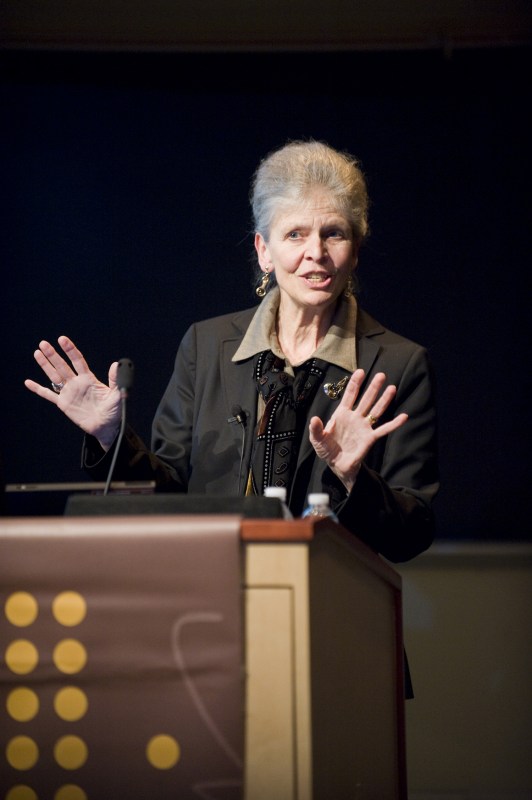
Joan Steitz, Ph.D., makes a point during her recent Discovery Lecture. (photo by Joe Howell)
Discovery Lecturer explores gene expression’s many forms
Following her Vanderbilt Discovery Lecture last week, Joan Steitz, Ph.D., who has discovered fundamental mechanisms of gene expression, made a confession.
“In the early '90s I almost wrote in a grant application that before I retired I wanted to know what all the small RNAs in a cell did,” said Steitz, a National Medal of Science winner who began her career in the mid-1960s as a graduate student under DNA double-helix co-discoverer James Watson, Ph.D.
“All of a sudden there were thousands more kinds of small RNAs,” she exclaimed to a rapt audience that filled the Light Hall lecture room to capacity.
For many years, RNA was thought to come in three basic forms: messenger RNA, a spliced or edited “transcription” of the DNA that moves from the nucleus to the ribosome, where it is “translated” into proteins; ribosomal RNA, which forms the ribosome; and transfer RNA, which brings amino acids to the ribosome for protein assembly.
Then in 1979, Steitz and her colleagues at Yale University described gene regulating complexes of small RNA and protein called small nuclear ribonucleoproteins or snRNPs. Several years later, a new class of gene expression modulators was added — microRNAs, fragments of RNA containing only about 22 nucleotides.
“There are probably upwards of 500 different species of microRNAs encoded by the human genome,” said Steitz, the Sterling Professor of Molecular Biophysics and Biochemistry at Yale and a Howard Hughes Medical Institute (HHMI) investigator.
“They probably are involved in regulating half of our genes at the post-transcriptional level,” she said. “And because of this they've been implicated in everything that's important — development, differentiation, disease.”
Like their larger counterparts, microRNAs also can bind proteins, creating microRNPs. Steitz and post-doctoral fellow Shobha Vasudevan, Ph.D., have found that microRNPs not only can shut down protein translation, but they can ramp it up, depending upon the cell cycle.
RNA fragments also play a role in infection. With another post-doc, Demian Cazalla, Ph.D., Steitz showed that a small RNA encoded by a primate herpesvirus can modulate gene expression in its host to the advantage of the virus. “This is sort of RNA warfare,” she said.
Steitz is not the only member of her family who has made major contributions to understanding gene expression.
Last month, her husband, fellow Yale professor and HHMI investigator Thomas Steitz, Ph.D., won a share of the 2009 Nobel Prize in Chemistry for his studies of the structure and function of the ribosome.
For a complete schedule of the Discovery Lecture series and archived video of previous lectures, go to http://www.mc.vanderbilt.edu/discoveryseries.













